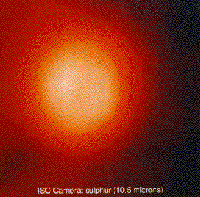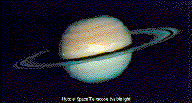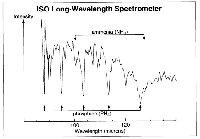
Nr 02-96 - Paris, 14 February 1996 [ Version française | Deutsche version ]

 Since the satellite's launch on 17
November 1995, teams of astronomers have received invisible
light from many cosmic sources while checking their
instruments.
Since the satellite's launch on 17
November 1995, teams of astronomers have received invisible
light from many cosmic sources while checking their
instruments.
Collisions between galaxies, each containing billions of stars, are the biggest events since the origin of the Universe. They may occur often enough to play a major role in the evolution of galaxies, and they provide a major theme for ISO's research teams. Collisions trigger star formation within dense dust clouds. These are opaque to visible light, so that even the Hubble Space Telescope is blind to the events within them.
 N.B.: Click on any picure to view the larger image & its description
N.B.: Click on any picure to view the larger image & its description
One target for ISO's Camera was a pair of galaxies known as
the Antennae, 60 million light-years away. The name comes
from antenna-like streamers of stars torn from the galaxies by
a collision. The galaxies look quite similar by visible light.
With its unprecedented ability to harvest and analyse infrared
rays, ISO distinguishes different kinds of commotion provoked
by the encounter.
 To ISO's penetrating infrared eye, one of the Antennae
galaxies shows a large ring of intense starmaking around the
central nucleus. This feature is absent in the other galaxy.
Another region of star formation extends along a line marking
the overlap of the disks of the two galaxies, where the
collision is fiercest. ISO's Camera has also observed merging
galaxies 230 million light-years away, known as Arp 220.
Here the intense infrared emission is concentrated in such a
small region that astronomers suspect a possible interaction
with a giant black hole.
To ISO's penetrating infrared eye, one of the Antennae
galaxies shows a large ring of intense starmaking around the
central nucleus. This feature is absent in the other galaxy.
Another region of star formation extends along a line marking
the overlap of the disks of the two galaxies, where the
collision is fiercest. ISO's Camera has also observed merging
galaxies 230 million light-years away, known as Arp 220.
Here the intense infrared emission is concentrated in such a
small region that astronomers suspect a possible interaction
with a giant black hole.
At a long infrared wavelength, ISO's Photometer has measured
the temperature of the dust in a pair of colliding galaxies,
NGC 6090. The result is minus 250 degrees Celsius.
Astronomers estimate the rate of starmaking in NGC 6090 at
25 sun-like stars created every year in NGC 6090, compared
with two or three a year in the Milky Way.
The nearby Whirlpool Galaxy, M51, was ISO's "first light"
target on 28 November, when the telescope was opened to the
sky. Since then the Camera team has made much better
pictures of M51. The infrared images show regions of star
formation along the galaxy's spiral arms and on either side of
the nucleus.

Prof. Catherine Cesarsky, from Saclay in France, is Principal Investigator for ISO's Camera. She comments : "What excites me most about ISO is that, with our sensitivity, we can look for starbursts in very young galaxies and trace the history of galaxies right through to the present era. Only by studying other galaxies can we fully understand our own Galaxy, the Milky Way, and how it created the conditions for life".
ISO also pursues starmaking processes within the Milky Way Galaxy. Penetrating the dusty clouds where stars are born, infrared rays can reveal protostars. These are strongly radiating cocoons of dust that surround new stars created by gravity squeezing the cloud. The spectrometers in ISO detect fingerprints of constituents of the clouds, by their emission or absorption of infrared rays at precisely defined wavelengths.
ISO's Short-Wavelength Spectrometer team tested their instrument on a dusty cloud called GL2591, which envelops a newly forming massive star. The astronomers have identified molecules in the solid state as ices, some of them never seen in space before, including hydrogen cyanide ice. Dr. Thijs de Graauw of Groningen in the Netherlands is Principal Investigator for ISO's Short-Wavelength Spectrometer.
"We want to know how the Sun and the Earth came into existence," Dr. de Graauw says, "and ISO is giving us wonderful new information. Our task with our high-resolution spectrometer is to analyse temperatures, pressures and motions within the nests where the stars hatch. Molecules and dust observations provide us with diagnostic tools".
The ability of ESA's new space telescope to see invisible
objects is graphically illustrated by an exploded star observed
by ISO's Photometer. In a part of the sky where ordinary
telescopes see only a few normal stars, this versatile
instrument has mapped an object one quarter of the width of
the Full Moon, glowing brightly in the infrared. The radiation
comes from debris travelling outwards at 3000 kilometres per
second from the scene of the explosion, which occurred about
1000 years ago. Called MSH 11-54, the object has also been
imaged by other space astronomers, using X-ray telescopes
such as Exosat. It lies 10000 light-years from the Earth in the
constellation of the Southern Cross.

MSH 11-54 is a supernova remnant, made by the explosion of a giant star at the end of its life. The debris of many supernovae litters the Milky Way and supplies it with chemical elements made from primeval hydrogen and helium by nuclear reactions in the stars. ISO will examine the transformation of the material as it fertilizes the Galaxy for the creation of new stars and planets, some of which may develop life.
"We owe our existence to the corpses of stars", remarks Prof. Dietrich Lemke of Heidelberg, Germany, who is Principal Investigator for ISO's Photometer. "Our bones, flesh and the iron that colours blood are built from atoms made in stars that expired before the Sun and the Earth were formed. In our studies of supernova remnants we expect to identify many atoms, molecules and dust particles. And we are looking out for diamonds, which may be scattered into space by the stellar explosions".
 Smaller stars expire less violently, but shed material into space
in clouds called planetary nebulae. All of the teams have made
original observations of planetary nebulae while verifying their
instruments, ISO's unique ability to range freely through the
infrared wavelengths is illustrated by a set of Camera images
of the planetary nebula NGC 6543. The cloud looks strikingly
different when seen by infrared emissions from hydrocarbons,
neon, sulphur and dust.
Smaller stars expire less violently, but shed material into space
in clouds called planetary nebulae. All of the teams have made
original observations of planetary nebulae while verifying their
instruments, ISO's unique ability to range freely through the
infrared wavelengths is illustrated by a set of Camera images
of the planetary nebula NGC 6543. The cloud looks strikingly
different when seen by infrared emissions from hydrocarbons,
neon, sulphur and dust.
The Long-Wavelength Spectrometer operates over a range of the infrared spectrum that is entirely blotted out by the Earth's atmosphere. Instruments in high-flying aircraft and balloons have glimpsed some features in the sky at long infrared wavelengths, but only ISO offers a clear view. As a result the Long-Wavelength Spectrometer has been able to observe, in a wide variety of cosmic settings, radiation that plays an important part in cooling the Milky Way Galaxy.
Emissions at a wavelength of 158 microns (about a sixth of
millimetre) come from ionized carbon atoms in the clouds that
fill the spaces between stars. The Long-Wavelength
Spectrometer has picked up the emissions from a region where
stars are being born, from a dying star, from warm and cool
clouds of dust and gas, and even from extremely cold clouds
of hydrocarbons called infrared cirrus. Although completely
invisible to the eye, the energy shed in this way may be
equivalent to the light of a billion stars. It affects the energy
budget - and therefore the temperature - of the Milky Way,
and of other galaxies too.


"Spectroscopy is an essential tool for investigating the physical and chemical conditions in astronomical objects," says Prof. Peter Clegg from London, Principal Investigator of ISO's Long-Wavelength Spectrometer. "ISO has now opened a new spectroscopic window on the cosmos that has already shed new light on the physics of planets, young and old stars, and galaxies. The next eighteen months are likely to transform our view of the universe."
The reason why ISO now enjoys an undisputed command of the infrared sky is that an infrared space telescope is difficult to build. It has to be colder than the cosmic objects it observes, and that means operating within a couple of degrees of absolute zero, below minus 271 degree Celsius. After the IRAS mission sketched an infrared view of the Universe in 1983, ESA was the first space agency to decide, in that same year, that infrared astronomy merited the heroic engineering required to build such a cold observatory and fly it in space. Instruments were conceived, and then industrial work began in 1986.
A large tank of superfluid helium surrounds the telescope and
its instruments. To maintain the low temperature, the helium
slowly evaporates. Eventually it will run out. The specification
required ISO to operate for 18 months. The latest estimate its
final operating temperature, is that this will be exceeded by
about 6 months and astronomical work should therefore
continue until November 1997. All systems in the spacecraft
are working well, and ISO is a triumph for the European
industrial teams that created it.

Once a day, ISO follows an elongated orbit around the Earth. It makes astronomical observations for 16 hours out of the 24, when it is clear of the radiation belts surrounding the planet. ESA's ground station at Villafranca is in direct communication with ISO during much of that time. NASA's station at Goldstone, California, covers the time when the satellite is below the Spanish horizon.
"From both the scientific and the engineering points of view, ISO is a big success for ESA", says Dr Martin Kessler, the mission's Project Scientist. "Until now, we have been verifying the instruments. The astronomy has started in earnest only this month. It involves about 500 teams from Europe, the USA and Japan, and more than a thousand astronomers. We will have much more to report at a meeting of astronomers at ESTEC in the Netherlands at the end of May".
For further information about ISO contact :